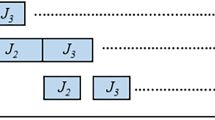Abstract
We consider the problem of minimizing makespan on identical parallel machines subject to release dates and delivery times. We present several new feasibility tests and adjustment techniques that consistently improve the classical energetic reasoning approach. Computational results carried out on a set of hard instances provide strong evidence that the performance of a state-of-the-art exact branch-and-bound algorithm is substantially improved through embedding the proposed enhanced energetic reasoning.
Similar content being viewed by others
References
Baptiste, P., & Demassey, S. (2004). Tight LP bounds for resource constrained project scheduling. OR Spektrum, 26, 251–262.
Baptiste, P., Le Pape, C., & Nuijten, W. (1999). Satisfiability tests and time bound adjustments for cumulative scheduling problems. Annals of Operations Research, 92, 305–333.
Brucker, P., Jurisch, B., & Kramer, A. (1994). The job-shop problem and immediate selection. Annals of Operations Research, 50, 73–114.
Carlier, J. (1987). Scheduling jobs with release dates and tails on identical machines to minimize the makespan. European Journal of Operational Research, 29, 298–306.
Carlier, J., & Pinson, E. (1989). An algorithm for solving the job-shop problem. Management Science, 35, 164–176.
Carlier, J., & Pinson, E. (1990). A practical use of Jackson’s Preemptive Schedule for solving job-shop problem. Annals of Operations Research, 26, 269–287.
Carlier, J., & Pinson, E. (1994). Adjustment of heads and tails for the job-shop problem. European Journal of Operational Research, 78, 146–161.
Carlier, J., & Pinson, E. (1998). Jackson’s pseudo preemptive schedule for the Pm/r j , q j /C max scheduling problem. Annals of Operations Research, 83, 41–58.
Dorndorf, U., Pesch, E., & Phan-Huy, T. (2000). A branch-and-bound algorithm for the resource-constrained project scheduling problem. Mathematical Methods of Operations Research, 52, 413–439.
Erschler, J., Lopez, P., & Thuriot, C. (1991). Raisonnement Temporel sous Contraintes de Ressources et Problèmes d’Ordonnancement. Revue d’Intelligence Artificielle, 5, 7–32.
Gharbi, A., & Haouari, M. (2002). Minimizing makespan on parallel machines subject to release dates and delivery times. Journal of Scheduling, 5, 329–355.
Gharbi, A., & Haouari, M. (2005). Optimal parallel machines scheduling with availability constraints. Discrete Applied Mathematics, 148, 63–87.
Gharbi, A., & Haouari, M. (2007). An approximate decomposition algorithm for scheduling on parallel machines with heads and tails. Computers and Operations Research, 34, 868–883.
Gusfield, D. (1984). Bounds for naive multiple machine scheduling with release times and deadlines. Journal of Algorithms, 5, 1–6.
Haouari, M., & Gharbi, A. (2003). An improved max-flow based lower bound for minimizing maximum lateness on identical parallel machines. Operations Research Letters, 31, 49–52.
Haouari, M., & Gharbi, A. (2004). Lower bounds for scheduling on identical parallel machines with heads and tails. Annals of Operations Research, 129, 187–204.
Horn, W. A. (1974). Some simple scheduling algorithms. Naval Research Logistics Quarterly, 21, 177–185.
Lahrichi, A. (1982). Ordonnancements: La Notion de “Parties Obligatoires” et son Application aux Problèmes Cumulatifs. RAIRO-RO, 16, 241–262.
Néron, E., Baptiste, Ph., & Gupta, J. N. D. (2001). Solving hybrid flow shop problem using the energetic reasoning and global operations. Omega, 29, 501–511.
Orlin, J. B. (1988). A faster strongly polynomial minimum cost flow algorithm. In Proceedings 20th ACM Symposium on Theory of Computing, 1988 (pp. 377–387).
Tercinet, F., Lenté, C., & Néron, E. (2004). Mixed satisfiability tests for multiprocessor scheduling with release dates and deadlines. Operations Research Letters, 32, 326–330.
Tercinet, F., Néron, E., & Lenté, C. (2006). Energetic reasoning and bin-packing problem for bounding a parallel machine scheduling problem. 4OR, 4, 297–318.
Vandevelde, A., Hoogeveen, H., Hurkens, C., & Lenstra, J. K. (2005). Lower bounds for the head-body-tail problem on parallel machines: a computational study of the multiprocessor flow shop. INFORMS Journal on Computing, 17, 305–320.
Author information
Authors and Affiliations
Corresponding author
Rights and permissions
About this article
Cite this article
Hidri, L., Gharbi, A. & Haouari, M. Energetic reasoning revisited: application to parallel machine scheduling. J Sched 11, 239–252 (2008). https://doi.org/10.1007/s10951-008-0070-z
Received:
Accepted:
Published:
Issue Date:
DOI: https://doi.org/10.1007/s10951-008-0070-z




